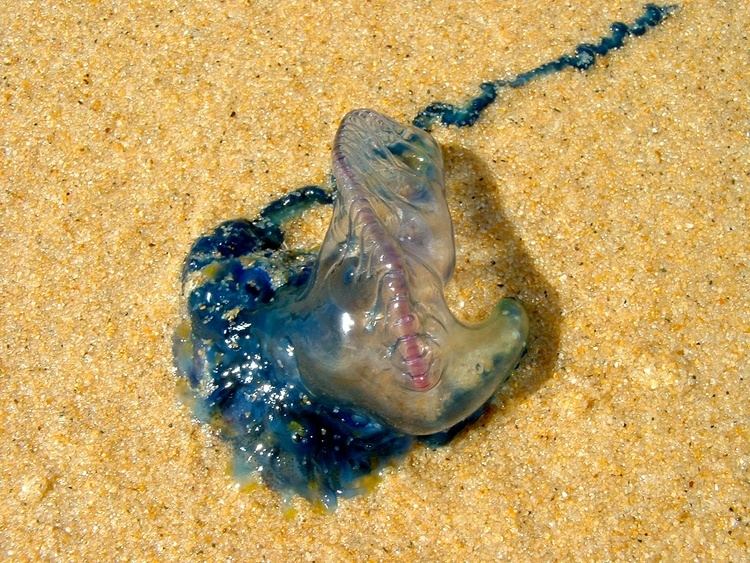Kingdom Animalia Order Siphonophora Genus Physalia Higher classification Physalia | Phylum Cnidaria Family Physaliidae Scientific name Physalia utriculus Rank Species | |
 | ||
Similar Jellyfish, Physalia, Portuguese man o' war, Cnidaria, Hydrozoa | ||
Pacific man o war physalia utriculus
Physalia utriculus, also called Blue Bottle or (Indo-Pacific) Portuguese Man-of-War, is a marine hydrozoan of the order Siphonophora found in the Indian and Pacific oceans. A gas filled bladder allows it to float on the surface, propelled by currents, tides, and by a sail at the top of the bladder, which may be left or right-handed. A single long tentacle of venomous cnidocytes, hanging below the float, provides the animal with a means of capturing prey.
Contents

Description

Physalia utriciulus, like the Portuguese man o' war, despite resembling a jellyfish is actually a siphonophore, a colony of tiny animals called zooids that are highly specialised, much like the organs of single multicellular organisms. It is composed of four separate colonies of polyps and medusoids. The colony consists of a gas-filled polyp that keeps it afloat, and three other polyp types called the gastrozooids, gonozooids and dactylozooids. Dactylozooids form tentacles that hang below the water's surface and detect and attack prey, and drag the prey up towards the gastrozooids (the digestive polyps), which attach their mouths and consume the food item. The gonozooids are adjacent to the gonozooids and constitute the reproductive structures of the colony, shedding eggs or sperm into the water.

P. utriculus is distinguished from the Atlantic Portuguese Man o' War (Physalia physalis) by the smaller size of the float (six inches compared to twelve) and by having a single long fishing tentacle. Like its larger relative, P. utriculus often occurs in swarms.
Distribution
P. utriculus is less widely distributed than the larger P. physalis, but it is the most common species on Australian coasts. It is also found in Hawaiian waters, where it is informally named ‘ili mane‘o or palalia.
Hazards
Individuals of P. utriculus sometimes become stranded on beaches, where their toxic nematocysts can remain potent for weeks or months in moist conditions. P. utriculus is responsible for most of the reported injuries on Australian beaches. On the east coast of Australia 10,000 to 30,000 stings per year from animals of the genus Physalia are reported. Most of the incidents are on the eastern coast, with only 500 or so in western and southern waters. Unlike P. physalis, no fatalities have been recorded for P. utriculus stings.
